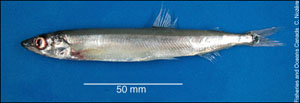Capelin
Latin Name
Mallotus villosus
Group Name
Pelagics
Habitat
Capelin have a circumpolar distribution throughout the arctic and subarctic regions of the world. In the northwestern Atlantic, they range from western Greenland and Hudson Bay in the north to Maine in the south and are most abundant around Newfoundland. Since the early 1990s, they have been observed in greater numbers in the southern Gulf of St. Lawrence and on the Scotian Shelf. In the eastern Atlantic, they are found from the Barents Sea to the coast of Norway, as well as in Icelandic coastal waters. In the Pacific, their range stretches from the Juan de Fuca Strait north along Alaska and across the Bering Sea to Siberia. From there, their range extends south, around Japan and toward Korea. Some stocks of capelin spend the bulk of their lives offshore, moving inshore only to spawn on beaches, while other stocks live their entire lives offshore, spawning on the bottom in deep water such as in the Barents Sea, in Icelandic waters, and on the Southeast Shoal of the Grand Bank.
Species Description
Capelin are small, slender fish that closely resemble smelt. They have a pointed snout with a slightly protruding lower jaw, a large dorsal fin and a small adipose fin behind it. They are silvery under their lateral line and green or olive-green above it, and their underside is silvery-white. During the spawning season, capelin exhibit sexual dimorphism, which means the head and back of males become darker; their pectoral, pelvic and anal fins are well-developed compared to females; and males have 'spawning ridges' consisting of a row of elongated scales just above the lateral line on either side of the body. Mature capelin are generally between 13 and 20 centimetres long, with the largest male found in Newfoundland waters at 25 centimetres long. Mature capelin can weigh as much as 40 and 45 grams, and rarely live longer than five years.
Historic changes in capelin and eulachon populations in the Strait of Georgia (1998). In Back to the Future: Reconstructing the Strait of Georgia Ecosystem. D. Pauley, T. Pitcher and D. Preikshot (editors). University of B.C. Fisheries Centre Research Reports 6 (5) 42:44. D.E. Hay
For more information, visit eCapelin.
- Date modified:
